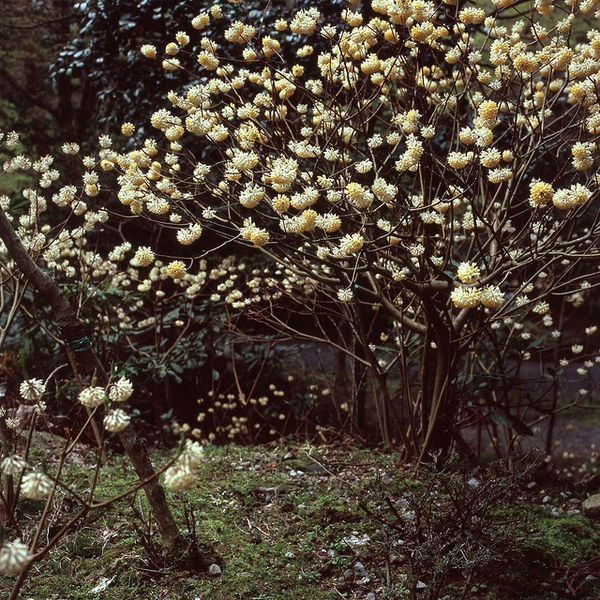Edgeworthia: A Fragrant Winter Treasure
- Sara S.
- 2 days ago
- 3 min read
Edgeworthia is a hidden gem among winter-blooming plants. Many of you may have experienced this shrub's captivating smell and beautiful blooms on a winter visit to the Biltmore Estate. With its delicate flowers, subtle fragrance, and captivating presence, Edgeworthia stands out as a star performer in the cold, dreary months and deserves a place in every garden! Learn more about this unique plant below.

Edgeworthia chrysantha, also known as Paperbush or Chinese Paper Bush, is a deciduous shrub that belongs to the Thymelaeaceae family. Native to the woodlands of China and the Himalayas, Edgeworthia has a rich history and has been cultivated for centuries. It is found in its native range along woodlands and stream banks. Chrysantha references the shrub’s yellow flowers. The common name “Paper bush” or “Rice Paper Plant” is in reference to the bark traditionally used to make paper. It was named after Michael Pakenham Edgeworth, an Irish botanist and plant collector who collected the plant while traveling through India. It doesn’t come as a surprise that Edgeworthia is related to Daphne odora. Daphne is also a fragrant, winter-blooming shrub preferring similar growing conditions.

Prized for its gardenia-scented winter blooms and unique form, this shrub makes a great specimen in a dappled shade garden in zones 7-10. Edgeworthia prefers light to moderate shade, plenty of moisture, and well-drained, humus-rich soil. It quickly forms a multi-stemmed, rounded, and somewhat spreading shape, reaching 4-6’ tall and wide. The leaves are long, narrow, and lance-shaped, with a velvety texture that adds to their charm. During summer, the foliage appears as a lush green backdrop to other plants in the garden. Plant this shrub in a prominent spot in your garden near a walkway or porch to allow the fragrance to be enjoyed! If your zone is borderline, plant in a spot that provides protection from winter winds.

In winter the flower buds begin to emerge and droop from the tips of the bare branches, and in late February the clusters of tubular blooms open to show a yellow interior. The flowers are accompanied by bright golden stamens that add a touch of vibrancy to the overall display. The blossoms, resembling tiny clusters of delicate tissue paper, lend the plant its common name, Paperbush. The sweet fragrance they emit is reminiscent of a mix between jasmine and honey, creating an alluring sensory experience. This fragrant delight can waft through your garden, attracting and supporting bees and other pollinators even during the chilly winter months.

The blooms remain from February to April before the new leaves emerge. After blooming, Edgeworthia continues to provide interest to the garden with its large, dark, blue-green foliage. The large leaves almost look tropical, and in a gentle breeze a silvery hue is exposed on the bottom side of the leaves. One of the most unique aspects of the form is the peculiar branching style - most branching points are in "threes!"
In its native regions, Edgeworthia holds cultural significance beyond its ornamental value. It has been used in traditional Chinese and Japanese medicine for its medicinal properties, including treating fever and inflammation. In Japanese culture, it is often associated with purification and used in religious ceremonies.
Winter Care: Caring for Edgeworthia during winter is relatively straightforward. While the plant is frost tolerant, it benefits from a protective layer of mulch around the base to insulate the roots. In colder climates, you can also cover it with burlap or a frost cloth during severe freezes. Pruning is typically done after flowering, allowing the shrub to develop new growth for the following year's blooms.
Pruning and Maintenance: Edgeworthia requires minimal pruning. After flowering, remove any dead or damaged wood and lightly shape the plant if necessary. Avoid hard pruning, as it can reduce next season's blooms. Edgeworthia is relatively pest and disease resistant, making it a low-maintenance addition to the garden.
.png)

